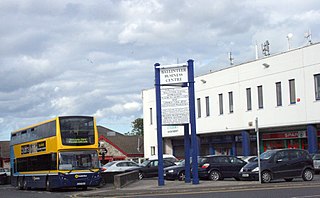Thomas Marlay could refer to:
- Thomas Marlay (judge), Irish politician and judge
- Thomas Marlay (British Army officer), Irish soldier and son of the judge
Thomas Marlay could refer to:

The Court of King's Bench was one of the senior courts of common law in Ireland. It was a mirror of the Court of King's Bench in England. The Lord Chief Justice was the most senior judge in the court, and the second most senior Irish judge under English rule and later when Ireland became part of the United Kingdom. Additionally, for a brief period between 1922 and 1924, the Lord Chief Justice of Ireland was the most senior judge in the Irish Free State.

Marlay Park is an 86 hectares suburban public park located in Rathfarnham in Dún Laoghaire–Rathdown, Ireland. Lying about nine kilometres from Dublin city centre, the parkland comprises woodlands, ponds and walks. Recreational spaces include a nine-hole, par-three golf course, tennis courts, six soccer pitches, five GAA pitches, a cricket pitch,a dog park, two children's playgrounds and a miniature railway run by the Dublin Society of Model and Experimental Engineers. There is also a craft courtyard with home craft shops and a coffee shop.

Glencairn House is the official residence of the British Ambassador to Ireland. Glencairn has been the official residence of successive ambassadors since the 1950s.

Ballinteer is a small southside suburb of Dublin, located in Dún Laoghaire–Rathdown, County Dublin, Ireland, extensively developed from the late 1960s onwards.
This is an, as yet, incomplete summary of the year 2005 in the Irish music industry.
Brinsley Butler, 2nd Earl of Lanesborough, PC (Ire), styled The Honourable until 1756 and Lord Newtown-Butler from 1756 to 1768, was an Irish politician and peer.

Celbridge Abbey is located in Celbridge, County Kildare in Ireland.
The High Sheriff of Westmeath was the British Crown's judicial representative in County Westmeath, Ireland from its creation under The Counties of Meath and Westmeath Act 1543 until 1922, when the office was abolished in the new Free State and replaced by the office of Westmeath County Sheriff. The sheriff had judicial, electoral, ceremonial and administrative functions and executed High Court Writs. In 1908, an Order in Council made the Lord-Lieutenant the Sovereign's prime representative in a county and reduced the High Sheriff's precedence. However the sheriff retained his responsibilities for the preservation of law and order in the county. The usual procedure for appointing the sheriff from 1660 onwards was that three persons were nominated at the beginning of each year from the county and the Lord Lieutenant then appointed his choice as High Sheriff for the remainder of the year. Often the other nominees were appointed as under-sheriffs. Sometimes a sheriff did not fulfil his entire term through death or other event and another sheriff was then appointed for the remainder of the year. The dates given hereunder are the dates of appointment. The following is an incomplete list: all addresses are in County Westmeath unless stated otherwise.

Robert Jocelyn, 1st Viscount Jocelyn PC (I) SL was an Anglo-Irish politician and judge and member of the Peerage of Ireland, best known for serving as Lord Chancellor of Ireland.
Arthur Blennerhassett KC was an Anglo-Irish lawyer, politician and judge. He is remembered mainly for killing John St. Leger in a duel.
Thomas Marlay was an Irish politician and judge, who ended his career as Lord Chief Justice of Ireland. He is remembered chiefly for beginning the rebuilding of Celbridge Abbey, and as the grandfather of the statesman Henry Grattan.

The Chief Baron of the Irish Exchequer was the Baron (judge) who presided over the Irish Court of Exchequer. This was a mirror of the equivalent court in England, and was one of the four courts which sat in the building in Dublin which is still called The Four Courts.

Richard Marlay was Dean of Ferns from 1769 to 1787; and Bishop of Clonfert and Kilmacduagh from 1787 to 1795 when he was translated to Waterford and Lismore. He died in office on 1 July 1802.
Michael Ford, was an Irish mezzotint engraver.
The Dean of Ferns is based at The Cathedral Church of St Edan, Ferns in the united Diocese of Cashel and Ossory within the Church of Ireland.
Richard Levinge was an Irish politician and landowner from County Kildare.
Sir John Marley or Marlay (1590–1673) was an English merchant, military commander and politician of the seventeenth century. He is best remembered for his heroic defence of Newcastle upon Tyne during the English Civil War, when he held the town for seven months against a besieging army on behalf of King Charles I. In poverty and desperation, he later betrayed the Royalist cause which he had served so loyally, and as a result, to the end of his life, he was reviled by many of his former comrades as a traitor.
Thomas Marlay (1719–1784) was an Irish soldier of the eighteenth century.

George Marlay was an Irish Anglican priest in the eighteenth century: he was Bishop of Dromore from 1745 until 1763. He gave his name to Marlay Park, which is now a popular amenity in south Dublin.

Charles Brinsley Marlay was an Anglo-Irish landowner and art collector.